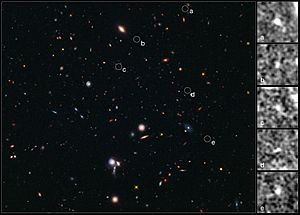Most distant things facts for kids

The universe is incredibly vast, and scientists are always looking for the most distant things we can find. These "things" are usually galaxies or powerful bursts of energy from inside galaxies. When we talk about how far away they are, we use two main measurements: redshift (called 'z') and billion light years (Gly).
As of 2012, astronomers had found about 50 possible objects with a redshift of z=8 or more, and another 100 candidates with z=7. Not all of them are listed here, but we'll show some of the most famous ones. Remember, 1 Gly means 1 billion light-years!
Contents
Measuring Cosmic Distances
What is a Light-Year?
A light-year is a way to measure huge distances in space. It's the distance light travels in one Earth year. Light moves incredibly fast – about 300,000 kilometers (186,000 miles) every second! So, a light-year is a very, very long distance. When we say something is 13 billion light-years away, it means the light we see from it today started its journey 13 billion years ago. We are essentially looking back in time!
Understanding Redshift
Redshift is another way scientists measure how far away objects are in space. Imagine a siren on an ambulance: as it moves away from you, the sound gets lower. Light works in a similar way. As galaxies move away from us, the light they give off gets "stretched" and shifts towards the red end of the light spectrum. The more an object's light is redshifted, the faster it is moving away from us, and the farther away it is. Scientists use the letter 'z' to represent redshift. A higher 'z' value means the object is more distant.
The Most Distant Objects We've Found
Scientists use powerful telescopes like the Hubble Space Telescope to find these incredibly distant objects. Many of them are very young protogalaxies, which are galaxies that are still forming. Others are gamma-ray bursts, which are extremely powerful explosions that happen when massive stars collapse or neutron stars merge.
Here are some examples of the most distant things we have observed:
| Name | Redshift (z) |
Distance (Gly) |
Type | Notes |
|---|---|---|---|---|
| GN-z11 | z = 11.09 | 13.39 | Galaxy | This is a confirmed galaxy. |
| EGSY8p7 | z = 8.68 | 13.23 | Galaxy | This is a confirmed galaxy. |
| GRB 090423 | z = 8.2 | 13.18 | Gamma-ray burst | A very powerful explosion. |
| EGS-zs8-1 | z = 7.73 | 13.13 | Galaxy | This is a confirmed galaxy. |
| z7 GSD 3811 | z = 7.66 | 13.11 | Galaxy | A distant galaxy. |
| z8 GND 5296 | z ≅ 7.51 | 13.1 | Galaxy | Note the small difference between its distance and redshift. |
| UDFj-39546284 | z ≅ 11.9 | 13.37 | Protogalaxy | This is a galaxy that is still forming. |
| MACS0647-JD | z ≅ 10.8 | 13.3 | Galaxy or protogalaxy | A candidate for the most distant galaxy. |
| MACS J1149-JD | z ≅ 9.6 | 13.2 | Galaxy or protogalaxy | |
| GRB 090429B | z ≅ 9.4 | 13.14 | Gamma-ray burst | Another powerful cosmic explosion. |
| UDFy-33436598 | z ≅ 8.6 | Galaxy or protogalaxy | ||
| GRB 090423 | z ≅ 8.2 | 13.035 | Gamma-ray burst | |
| BoRG-58 | z ≅ 8 | Cluster or protocluster | A group of galaxies or forming galaxies. | |
| A1689-zD1 | z ≅ 7.6 | 13 | Galaxy or protogalaxy | A distant galaxy. |
| SXDF-NB1006-2 | z ≅ 7.215 | 12.91 | Galaxy or protogalaxy | A distant galaxy. |
| GN-108036 | z ≅ 7.213 | 12.91 | Galaxy or protogalaxy | A distant galaxy. |
| BDF-3299 | z = 7.109 | 12.9 | Galaxy or protogalaxy | Confirmed by spectroscopic redshift. |
| ULAS J1120+0641 | z ≅ 7.085 | 12.9 | Quasar | A very bright and active galaxy. |
| A1703 zD6 | z ≅ 7.045 | 12.89 | Galaxy or protogalaxy | |
| BDF-521 | z = 7.008 | 12.89 | Galaxy or protogalaxy | Confirmed by spectroscopic redshift. |
| IOK-1 | z ≅ 6.964 | 12.88 | Galaxy or protogalaxy | |
| LAE J095950.99+021219.1 | z ≅ 6.944 | Galaxy or protogalaxy | This is a faint galaxy that emits a specific type of light called Lyman-alpha. |
One of the furthest confirmed objects, meaning its distance has been carefully checked, is UDFy-38135539. It is about 13.1 Gly away!
Related Pages
- Galaxy
- List of galaxies
- IC 1101: This is the largest known galaxy, with about 100 trillion stars!


